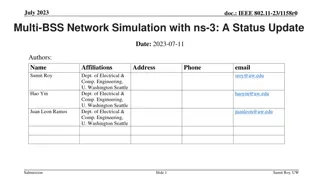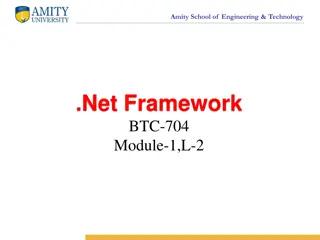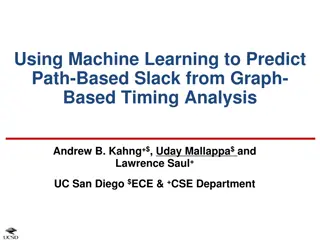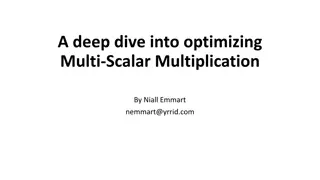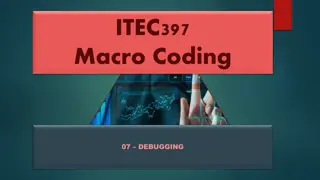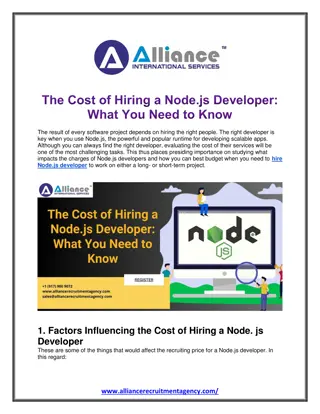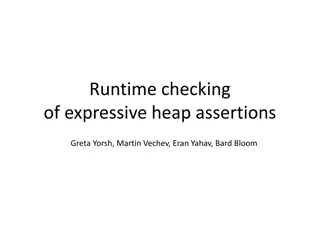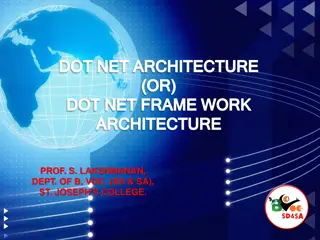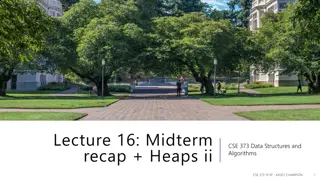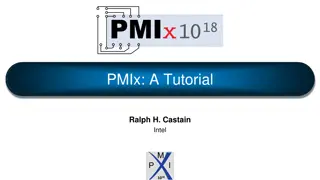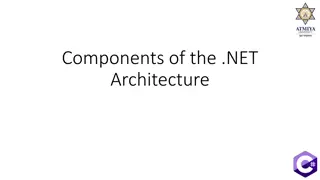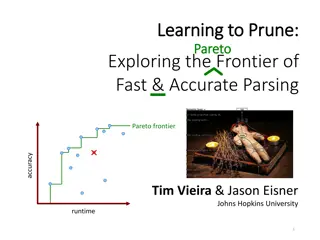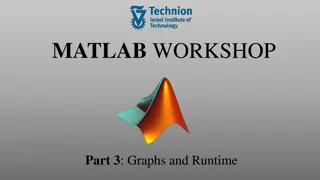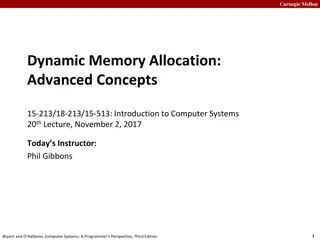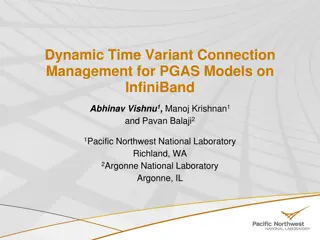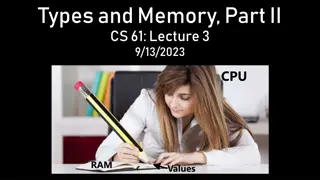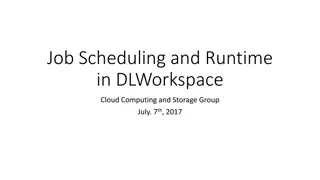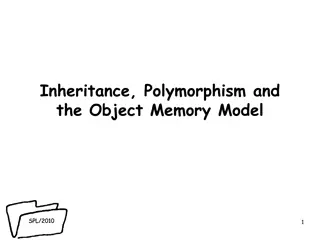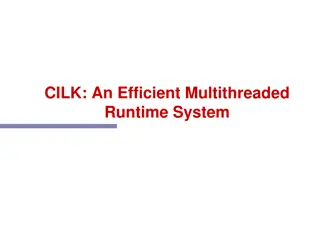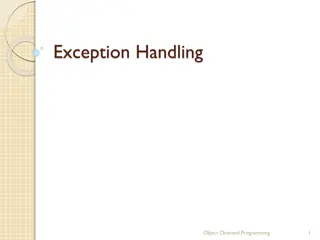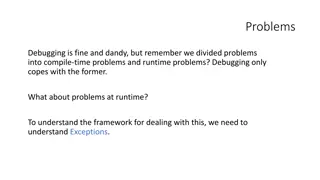Algorithm Analysis
Algorithm analysis involves evaluating the efficiency of algorithms through measures such as time and memory complexity. This analysis helps in comparing different algorithms, understanding how time scales with input size, and predicting performance as input size approaches infinity. Scaling analysi
1 views • 30 slides
Multi-BSS Network Simulation in ns-3 with IEEE 802.11-23 Update
A status update on the WiFi module in ns-3 for IEEE 802.11-23 focusing on advancements like new protocol features, AI/ML integration, and runtime improvements for multi-BSS networks. The simulations cover throughput benchmarks, multi-BSS scenarios, interference parameters, and validation against ana
13 views • 33 slides
Line Segment Intersection
Geometric intersections play a crucial role in computational geometry for tasks such as solid modeling, collision detection in robotics, and overlaying subdivisions in geographic information systems. The problem of line segment intersection involves finding all intersection points between a set of c
0 views • 17 slides
BTR: Binary Token Representations for Efficient Retrieval Augmented Language Models
Retrieval-augmented language models like BTR address issues such as hallucination by providing efficient solutions for encoding input passages and queries. By utilizing cacheable binary token representations, BTR offers a unique approach to decomposing and binarizing passage encoding to improve runt
0 views • 9 slides
Overview of .NET Framework and CLR Architecture at Amity School of Engineering
Explore the .NET Framework and Common Language Runtime (CLR) architecture at Amity School of Engineering & Technology, covering topics such as .NET components, technical architecture, common language runtime, CLR execution model, and more. Discover the support for multiple languages and the .NET lan
0 views • 28 slides
Dynamic Memory Allocation in Computer Systems: An Overview
Dynamic memory allocation in computer systems involves the acquisition of virtual memory at runtime for data structures whose size is only known at runtime. This process is managed by dynamic memory allocators, such as malloc, to handle memory invisible to user code, application kernels, and virtual
0 views • 70 slides
Machine Learning for Predicting Path-Based Slack in Timing Analysis
Utilizing machine learning to forecast path-based slack in graph-based timing analysis offers a solution for optimizing power and area efficiency in the design process. The Static Timing Analysis incorporates accurate path-based analysis (PBA) and fast graph-based analysis (GBA) to estimate transiti
1 views • 31 slides
Understanding Exceptions in Computer Science
Errors in programming, such as syntax, semantic, runtime, and logical errors, can disrupt the execution of a program. Syntax errors relate to grammatical violations, semantic errors occur when statements lack meaning, and runtime errors happen during program execution due to illegal operations. By i
1 views • 35 slides
Techniques for Reducing Connected-Standby Energy Consumption in Mobile Devices
Mobile devices spend a significant amount of time in connected-standby mode, leading to energy inefficiency in the Deepest-Runtime-Idle-Power State (DRIPS). This study introduces Optimized DRIPS (ODRIPS) to address this issue by offloading wake-up timer events, powering off IO signals, and transferr
1 views • 31 slides
Advanced Memory Dump Analysis with WinDbg for Developers
Dive into the intricacies of memory dump analysis using WinDbg, focusing on essential techniques like writing memory dumps, collecting evidence, configuring WinDbg, loading dump files, and leveraging key extensions. Gain insights on symbol management, runtime debugging, and more to effectively troub
0 views • 21 slides
Understanding Real-Time Systems and Operating Systems
Real-time systems in computing refer to the concept of task execution meeting specific deadlines, with examples including process control in industrial plants, robotics, air traffic control, and more. Tasks in real-time systems have defined release, schedule, completion times, and deadlines, with ru
0 views • 46 slides
Understanding Sorting Algorithms in Data Structures
Delve into the world of sorting algorithms in data structures through comprehensive coverage of concepts, performance optimization tips, and associative set/map implementations. Explore various sorting strategies and understand the importance of efficient coding practices for enhanced runtime perfor
0 views • 82 slides
Optimizing Multi-Scalar Multiplication Techniques
Delve into the world of optimizing multi-scalar multiplication techniques with a focus on improving performance, especially in Zero Knowledge Proofs systems using elliptic curves. Explore algorithmic optimizations like the Bucket Method by Gus Gutowski and learn about the runtime breakdown, motivati
3 views • 52 slides
Proposal for Updating End-to-End Test Smoketests Using Python SDK
Addressing the current scenario and problems encountered in running E2E tests for VNF. Proposals for a 3-stage E2E test setup, including test preparation, vendor and LCM creation, runtime complexities, and cloud region configurations. Suggestions for utilizing SO Openstack and MultiCloud VIM adapter
1 views • 5 slides
Understanding Debugging in Programming
Debugging is a crucial aspect of programming to identify and fix errors that can cause program failures, hangs, or unexpected results. There are different types of errors such as compile errors, runtime errors, and logic errors, each requiring a different approach to resolve. Learning about the mode
0 views • 20 slides
The Cost of Hiring a Node.js Developer What You Need to Know
The result of every software project depends on hiring the right people. The right developer is key when you use Node.js, the powerful and popular runtime for developing scalable apps. Although you can always find the right developer, evaluating the cost of their services will be one of the most cha
0 views • 6 slides
Runtime Checking of Expressive Heap Assertions
Motivated by the unreliability of large software systems due to concurrency bugs and limitations of static analysis, the goal is to enable runtime analysis of deep semantic properties with low overhead. This involves checking expressive heap assertions at runtime with minimal impact on performance,
0 views • 15 slides
Understanding ReDoS Attacks in Web Applications
The article discusses the vulnerability of web applications to Zero-Day ReDoS attacks and the impact of Regular Expression Denial of Service (ReDoS). It explores the use of regex in HTTP requests, the severity of ReDoS incidents, and practical examples of ReDoS vulnerabilities in popular websites an
2 views • 31 slides
Understanding .NET Framework Architecture and Common Language Runtime
This content delves into the intricacies of .NET architecture, highlighting its structure, common language runtime, and key components such as Common Type System (CTS) and Common Language System (CLS). It explains how .NET supports multiple languages, facilitates cross-language interoperability, and
0 views • 13 slides
Using MATLAB Tools for Enhanced Programming Capabilities
Exploring the power of MATLAB tools such as MATLAB Compiler and Runtime, MATLAB Coder, and MATLAB Engine for Python can greatly enhance your programming capabilities. These tools allow you to create standalone applications, generate C/C++ code, call Python from MATLAB, and utilize parallel computing
0 views • 9 slides
Scientific Machine Learning Benchmarks: Evaluating ML Ecosystems
The Scientific Machine Learning Benchmarks aim to assess machine learning solutions for scientific challenges across various domains like particle physics, material sciences, and life sciences. The process involves comparing products based on large experimental datasets, including baselines and mach
1 views • 35 slides
SAT-Based Exact Synthesis Using DAG Topology Families
Explore the world of exact synthesis in digital circuit design utilizing SAT solvers to achieve precise results. Understand the challenges, decision problems, algorithms, motivation behind exact synthesis, and the contribution of SAT solvers in mitigating runtime. Discover the concept of DAG topolog
0 views • 17 slides
Implementing Heaps: Node Operations and Runtime Analysis
Understanding the implementation of heaps involves knowing various node operations like finding the minimum node, last node, next open space, children, and parent. The runtime analysis of heap operations such as peekMin, removeMin, and insert are crucial for optimizing performance. This recap covers
0 views • 9 slides
Dynamic Memory Management Overview
Understanding dynamic memory management is crucial in programming to efficiently allocate and deallocate memory during runtime. The memory is divided into the stack and the heap, each serving specific purposes in storing local and dynamic data. Dynamic memory allocators organize the heap for efficie
0 views • 31 slides
Overview of PMIx: A Comprehensive Tutorial
Dive into an in-depth tutorial on PMIx, covering topics such as server and scheduler overview, client tools, terminology, session allocation, job management, application workflows, and launch sequences. Explore the changing landscape of programming models and runtime proliferation, along with strate
0 views • 117 slides
Understanding the .NET Architecture Components
The .NET architecture comprises various key components such as the Common Language Specification, Code Manager, Managed Code, Unmanaged Code, and Native Code. These components play crucial roles in the development and execution of applications within the .NET framework. Managed code is executed by t
0 views • 21 slides
Comparison of C vs Rust Programming Languages
C and Rust are programming languages known for their efficiency in resource-constrained environments. While C offers direct control over hardware and is favored by advanced programmers for its performance, Rust provides memory safety features that prevent common errors like null pointer dereferences
0 views • 50 slides
Exploring Fast & Accurate Parsing With Learning to Prune
In this informative content, the concept of learning to prune is discussed in the context of exploring the frontier of fast and accurate parsing. It delves into the optimization tradeoff between runtime and accuracy in end-to-end systems, showcasing a Pareto frontier of different system performances
0 views • 42 slides
MATLAB Workshop: Graphs, Runtime Analysis, and Plotting Techniques
MATLAB Workshop Part 3 delves into the creation of 2D and 3D plots, along with advanced plotting commands, runtime analysis using tic and toc functions, and the utilization of the MATLAB profiler. The content demonstrates techniques for plotting multiple curves, creating subplots, and visualizing da
0 views • 22 slides
Understanding Dynamic Memory Allocation in Computer Systems
Dynamic memory allocation in computer systems involves the use of memory allocators like malloc to acquire virtual memory at runtime for data structures whose size is only known during execution. Different methods such as implicit lists and explicit lists are used to keep track of free blocks for ef
0 views • 62 slides
Understanding Runtime Recovery of Web Applications under Zero-Day ReDoS Attacks
This detailed content discusses the critical issue of Runtime Recovery of Web Applications facing Zero-Day ReDoS Attacks. It delves into the significance of regular expressions (regex) in handling HTTP requests, highlighting vulnerabilities and real-world impacts. The research emphasizes the severit
0 views • 31 slides
Dynamic Time-Variant Connection Management for PGAS Models on InfiniBand
Scalable communication data structures are crucial for runtime systems, with a focus on efficient connection management for PGAS models on InfiniBand systems. The research explores on-demand process creation, persistent connections, use cases, problem statements, and design choices for disconnection
0 views • 21 slides
Transparent and Efficient CFI Enforcement with Intel Processor Trace
This research discusses Control Flow Integrity (CFI) enforcement to combat control flow hijacking attacks. It explores methods for runtime CFI enforcement, including instrumented checking and transparent monitoring. The study delves into trace mechanisms, buffer management strategies, and when to tr
0 views • 32 slides
Understanding CPU and RAM Relationship in Memory Segments
A program's address space consists of four segments - code, static data, stack, and heap. Each segment plays a crucial role in memory allocation and management. The OS and C++ runtime handle the allocation and deallocation of memory in the heap segment. Garbage collectors in certain languages aid in
0 views • 22 slides
Understanding DLL Hijacking in Windows
Dynamic-Link Libraries (DLLs) are a mechanism in Windows for sharing code and data, making it easier to design and build applications. By loading DLLs either statically at compile time or dynamically at runtime, programs can enhance memory management and user experience. However, DLL hijacking, a co
0 views • 13 slides
Efficient Job Scheduling and Runtime Management in DLWorkspace Cloud Computing and Storage Group
Explore the intricate system of job scheduling and runtime management in DLWorkspace, involving SQL server, K8s Master API, Web Portal, Restful API, Cluster Manager, NVIDIA driver plugins, and shared storage. Learn about the process flow from job submission to approval, status monitoring, and device
0 views • 11 slides
Understanding Object Memory Management in Programming
Exploring how objects are stored in memory at runtime, this content delves into the concepts of inheritance, polymorphism, and the object memory model. It discusses how objects are implemented in memory, the allocation of class data members, and the storage of object values and references. The text
0 views • 61 slides
Understanding CILK: An Efficient Multithreaded Runtime System
CILK is a multithreaded runtime system designed to develop dynamic, asynchronous, and concurrent programs efficiently. It utilizes a work-stealing thread scheduler and relies on a directed acyclic graph (DAG) model for computations. With a focus on optimizing critical paths and total work, CILK enab
0 views • 44 slides
Understanding Exception Handling in Object-Oriented Programming
Exception handling in object-oriented programming enables a program to manage and recover from exceptional situations during runtime errors. Java uses exceptions to represent errors, allowing methods to throw exceptions that can be caught and handled by the caller, thus separating error detection an
0 views • 21 slides
Understanding Python Exceptions for Handling Runtime Problems
Exceptions in Python are essential for handling runtime problems and preventing programs from crashing unexpectedly. By using try-except blocks, developers can catch and manage exceptions that occur during program execution, ensuring smooth functioning. Learn how to effectively utilize exceptions to
0 views • 15 slides

